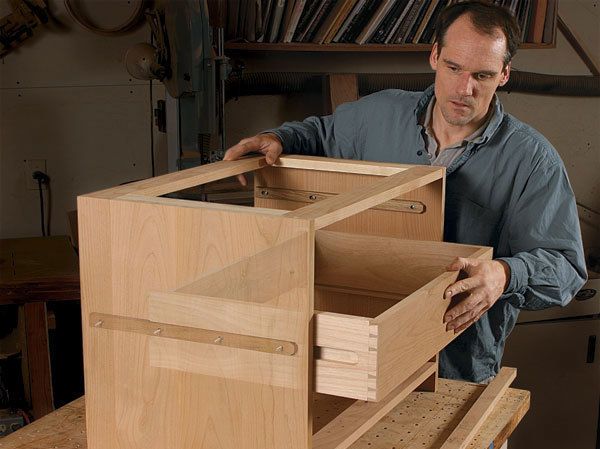Side-Hung Drawer Slides
Hardwood guides install with relative ease and make for durable, smooth-gliding, sure-stopping drawers
Synopsis: Mark Edmundson has constructed all sorts of drawer systems, from traditional drawer pockets with rails, kickers, and runners, to elaborate center-hung systems. But to him, nothing beats the simplicity and adjustability of side-hung guides — wooden guides mounted to case sides or table aprons that mate with grooves in the drawer sides. The guides not only support the drawer as it is opened and closed, but they also prevent tipping and serve as drawer stops. Side-hung drawers are found on everything from utility cabinets to elegant chests of drawers and tables. And they’re easy to install, as Edmundson demonstrates.
Over the years I’ve constructed all sorts of drawer systems, from traditional drawer pockets consisting of rails, kickers, and runners, to elaborate center-hung guides. But nothing beats the simplicity and adjustability of side-hung guides. With this system, wooden guides are mounted to the case sides or table aprons and mate with grooves in the drawer sides. The guides support the drawer as it is opened and closed, and they also serve as the kickers (to prevent tipping) and drawer stops.
You will find side-hung drawers on everything from utility cabinets to elegant chests of drawers to tables—and for good reason. Without the need for the rails of a traditional drawer pocket, sidehung guides allow you to design a bank of drawers with a clean, uninterrupted façade. They also allow for deeper drawer boxes.
Most important, however, is the straightforward installation. Side-hung guides make it easy to achieve perfectly fitting drawers in a chest or table, and will provide smooth-gliding service for many years.
Side-hung guides simplify a chest of drawers
Fitting drawers is an exercise in trial and error. Too tight a fit, and the drawer will jam when the weather is moist; too sloppy a fit, and the drawer will bind and slide roughly in the opening. Using side-hung guides does not exempt you from building a cabinet with a straight and smooth drawer pocket, but it does simplify the process of hanging a bank of drawers.
Make the guides as thick as possible—When sizing the guides for a chest of drawers, consider how much weight the drawers will carry. In general, drawers that carry a lot of weight need beefier guides. A rule of thumb is to make the guides about 3⁄4 in. to 1 in. wide and as thick as possible without compromising drawer strength. Also, because of the abuse the guides must endure, make them of a hard-wearing wood, such as teak or ash. Teak is ideal because its oily nature makes for smooth-gliding action.
Side-hung guides have a couple of key requirements when it comes to the drawer construction. First, the sides must be thick enough to allow for the grooves that mate with the guides. Generally, for strength there should be at least 1⁄4 in. of wood remaining between the bottom of the groove and the inside of the drawer. Also, cutting the drawer back about 1⁄4 in. shorter in height than the sides and the front allows you to plow the grooves in both sides with only one stop setup.
From Fine Woodworking #184
For the full article, download the PDF below:
Fine Woodworking Recommended Products

Jorgensen 6 inch Bar Clamp Set, 4 Pack

Bessey EKH Trigger Clamps

Dubuque Clamp Works Bar Clamps - 4 pack























Log in or create an account to post a comment.
Sign up Log in